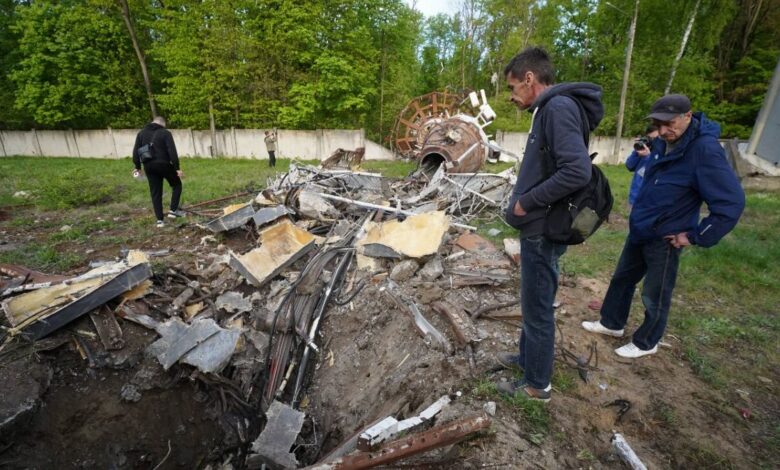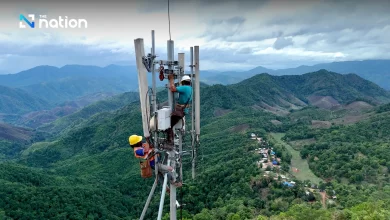Ukraine facing €4.38 billion post-war bill to restore telecom industry crippled by Russian attacks

It will take 10 years and billions of euros to repair vital infrastructure telecommunications network in Ukraine, officials say.
Ukraine estimates that it will need $4.67 billion (€4.38 billion) over 10 years to repair an overlooked but expensive casualty in the ongoing Russian invasion: its telecommunications network.
Stanislav Prybytko, the Director-General of the Directorate for mobile broadband in Ukraine’s Ministry of Digital Transformation, told Euronews Next in a series of estimates that Russia has destroyed over 4,300 mobile base stations and a quarter of the country’s internet networks since February 2022.
The country’s fibre optic network has also been impacted, with more than 30,000 km of cables spread out throughout Ukraine damaged or destroyed in the fighting so far.
“The war continues, and the losses are increasing with each passing day,” Prybytko told Euronews Next.
“Electronic communications are one of the strategic and most important areas for the functioning of the state… any breakdowns or failures in this sector have critical consequences for every sphere of population existence”.
Where most of the loss is happening
The World Bank put the estimated damage to the telecommunications sector closer to $2.1 billion (€1.97 billion) in a December 2023 report seen by Euronews Next, but confirmed Prybytko’s figure for overall need.
That’s because Ukraine’s build-back plan would include not only the physical repairs to telecoms infrastructure but “capacity building in cybersecurity and other areas”.
This damage to critical communications infrastructure, the report continued, went up 29 per cent from 2022 to 2023.
The World Bank report found telecommunications damage is not felt the same way throughout the country, nor by who provides those services.
Forty-five per cent of the total network damage is felt by fixed broadband operators, followed closely by mobile operators at 43 per cent.
The rest is scattered between the postal service and broadcasters.
Operators for Lifecell and Vodafone Ukraine, two of three “backbone” telecom companies operating in the country, told Euronews Next that so far their companies have been able to take on the costs that come with their damaged networks but won’t be able to do so if the war continues indefinitely.
Vodafone has already spent 2 billion hryvnia (€47 million) on repairing over 900 of their damaged sites, but a representative from the company previously told Euronews Next that the damage could be worth twice that amount.
A similar picture at Lifecell, where at least 1,000 sites have been repaired since the beginning of the invasion at the cost of $150 million (€138 million) from the company’s own profits.
For smaller providers, the picture is much less positive.
Roughly 720 mobile and internet providers “have suffered substantial losses” during the course of the war, Prybytko said, with just under 100 of them at the brink of bankruptcy.
The heaviest hit area for telecommunications damage is tied between the Donetska Oblast and Kharkivska Oblast with 17 per cent each, according to the World Bank report.
The areas of Zaporizka Oblast, Khersonska Oblast, and Kyivska Oblast have also been hard hit, all accounting for between 11 to 13 per cent of the country’s total telecommunications infrastructure damage.
Prybytko said the estimates are still the most reliable the government has, but might not reflect the damages already done in the first months of 2024.
‘Extremely difficult’ to reach occupied areas of Ukraine
Prybytko and the World Bank’s estimates only include the damage surveilled in non-Russian occupied areas.
Prybytko, along with Lifecell and Vodafone told Euronews Next that it’s “extremely difficult” to scope out the damage in Russian-occupied areas of the country.
Russia occupies parts of the Donetsk, Kherson, Luhansk, Mykolayiv, and Zaporizhzhya regions of Ukraine as well as the island of Crimea.
“The first thing the Russians do after occupying Ukrainian cities is to deprive people of communication,” Prybytko said.
“Often, they completely destroy or undermine the telecommunications infrastructure or take equipment to Russia”.
Engineers are regularly sent out to the front lines of the Ukrainian war effort with only a helmet and a small first aid kit to repair mobile base stations that have been hit by Russian shelling, Lifecell and Vodafone previously told Euronews Next.
Their staff are only sent out when it is determined safe enough to do so. On some occasions, both providers said their staff have been embedded with Ukraine’s national defence forces to conduct their repairs in unsafe areas.
Prybytko said it will be difficult to restore telecommunications to their pre-war level until there are “conditions for the safe living of consumers and service providers”.
Still, the World Bank estimates that roughly 12 per cent of all Ukrainian households have lost mobile service connection: an issue, the report notes, that “affects not only personal communication but also critical services and economic activities”.
‘Decentralisation saves us’
Despite what Prybyto calls “constant shelling,” he said he wants Ukraine’s allies to know that the government and private providers are working together to keep citizens connected.
The government gave the example of Kharkiv, where they say 80 per cent of the city’s mobile base stations are still operational even though “almost all the critical energy infrastructure is nearly destroyed,” by recent Russian attacks.
“This is possible, in part, because the operator companies have prepared in advance for outages, procured generators, and set up technical teams to work in critical conditions,” Prybytko said.
From the first day of the war, Prybytko said his ministry, the country’s telecommunications regulators, and individual providers joined forces to make sure that Ukrainians are able to stay connected. That means mobile operators share cell towers, generators and even their bases are destroyed.
The country’s three major operators also got rid of in-country roaming early on in the invasion, so customers could stay connected with one network or another.
Ukraine is filling any gaps in this private telecommunications service with other types of communication, Prybytko said.
Ukraine is also one of the biggest users of SpaceX’s Starlink, a series of satellites in space that transmit radio signals to users on Earth, with 47,000 units being used by the country, according to Prybytko.
“If fixed Internet fails due to a power outage, mobile communication helps, and vice versa,” Prybytko said.
“And if the Russian occupiers completely destroy traditional networks, Starlink satellite communication comes to the rescue.
“[This] decentralisation saves us”.
In some cases, Prybytko said, the telecommunications industry is even growing.
During the second year of the invasion, the government said they set up Internet access in over 5,000 educational shelters, 3,500 preschools and 571 healthcare facilities.
One of their goals this year, Prybytko said, is to open free WiFi zones in libraries, schools and service centres. A new pilot for 5G networks could follow.
Ukraine is also working on making their field of electronic communications “more transparent,” for their “eventual integration into the European Union,” Prybytko said.
This is the second part of a two-instalment series looking at the impact of the Russian invasion on Ukraine’s embattled telecommunications. Read the first part here.



